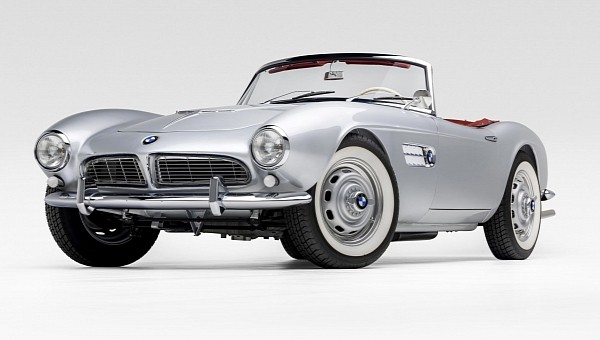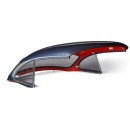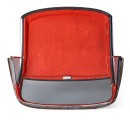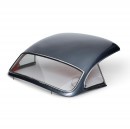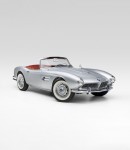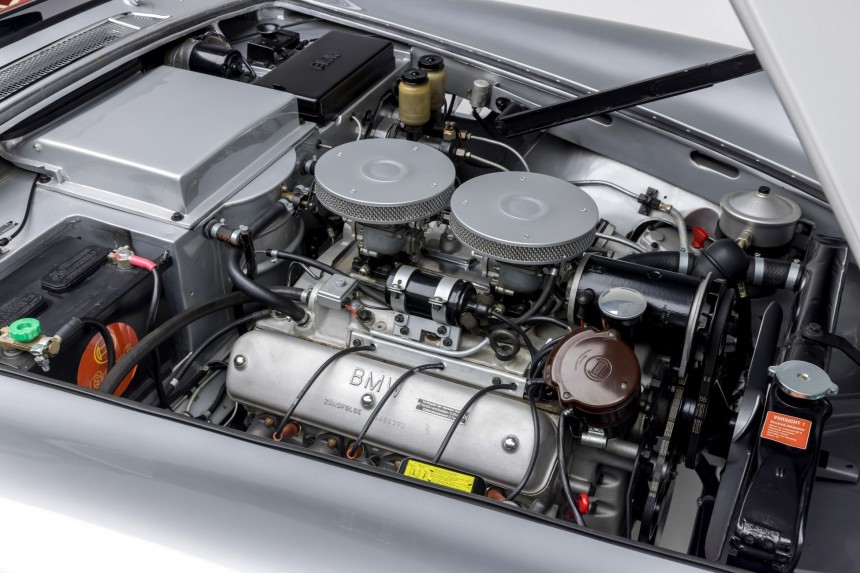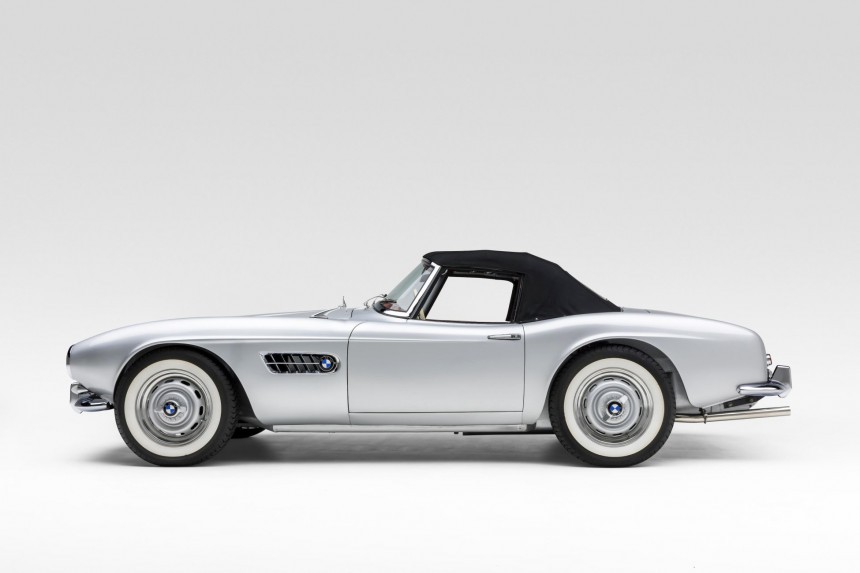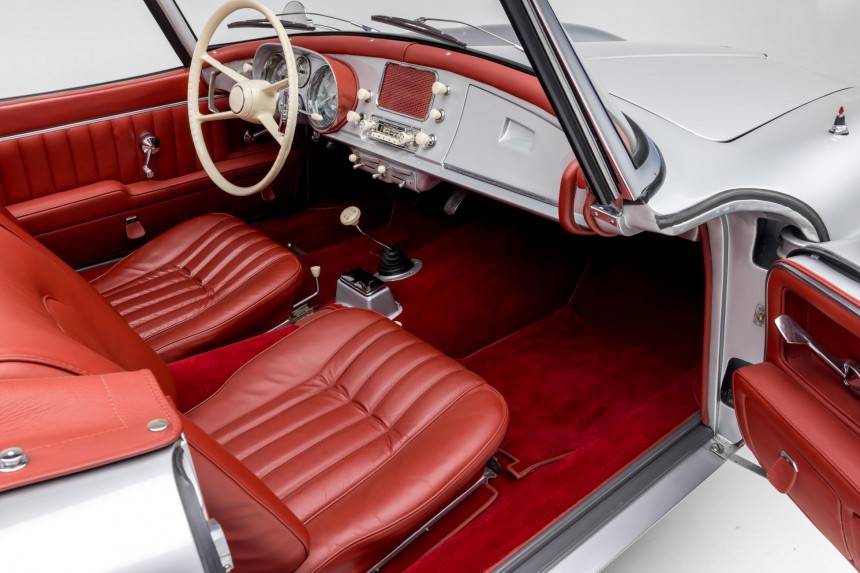A BMW roadster is always attractive, especially when we talk about BMW 507, produced in only 252 units. One of those examples is for sale at an auction on January 27, 2023, in Scottsdale, Arizona, U.S. But for BMW, this car has been a nightmare.
Like the Mercedes 300 SL, the BMW 507's history is linked to the name of Max Hoffman, the Austrian-born industrialist who imported various makes of cars to the U.S. in the 1950s. He convinced BMW management to produce a roadster to fill the gap between the Mercedes 300 SL Roadster and the cheaper, less performant Triumph and M.G. models. Hoffman also made a business plan so BMW could sell 5,000 units in the U.S. for about $5,000 each.
Initially, the design was made by Ernst Loof, but Hoffman was not thrilled with the car's look. At Hoffman's insistence, in November 1954, BMW hired Albrecht von Goertz to create the new roadster. Albert von Goertz was a freelance industrial designer who was involved in designing a wide range of products, from fountain pens to furniture, but he never created a complete car. Fritz Fiedler and Alex von Falkenhausen took care of the mechanical side. Meanwhile Goertz made regular trips between Germany and the U.S. to supervise the design of the 1:1 scale model.
The BMW 507 used a shortened chassis derived from the 503, with the wheelbase decreased from 2,835 mm (111.6 in) to 2,480 mm (98 in). Because the 503's chassis was too heavy, BMW used more aluminum on the 507, and almost the entire body was handmade from aluminum. Thus, in the end, the curb weight was 1,330 kg (2,930 lb).
Under the hood was a 3,168 cc (193.3 cu in) V8 OHV pushrod engine. Codenamed M507/1, the engine in the 507 featured a pair of Zenith 32 NDIX two-barrel carburetors and had a compression ratio of 7.8:1 allowing it to develop a power output of 112 kW (152 ps/150 hp) /5000 rpm.
As a result, the 507 could sprint from 0 to 100 kph (62 mph) in 11 seconds and reach a top speed of 200 kph (125 mph). Its performance was good for the time but inferior to the Mercedes 300 SL Roadster, which could get up to 237 kph (147 mph) and sprint from 0 to 100 kph (62 mph) in 7.9 seconds.
But that wasn't the BMW 507's biggest problem; it was the price. Hoffman's business plan was based on a $5,000 price tag, and the carmaker fell far short of that target. The initial selling price was 26,500 DM in Germany and $9,000 in the U.S., which was almost double. Later, the price rose to $10,500 in the U.S.
You could get the Mercedes 300 SL Roadster at nearly the same price: $10,920 in the U.S. Furthermore, the 507 costs almost twice that of a Ford Thunderbird or a Chevrolet Corvette. Production of the BMW 507 began in November 1956, and due to the high price, BMW only managed to sell 252 examples (254 in total, including two prototypes).
Among the buyers were many celebrities, but this did not help boost sales. The list of celebrities is impressive: film actors Alain Delon, David Carradine, and Ursula Andress, Elvis Presley, Prince Rainier of Monaco, King Constantine II of Greece, Aga Khan, racing drivers John Surtees and Hans Stuck.
BMW lost money on every model it produced. The failure of the 507 contributed to a significant loss of D.M. 15 million in 1959, which brought the Bavarian firm close to bankruptcy. Only Herbert Quandt's capital injection saved BMW at the time.
BMW built two 507 series. The first series was created in only 34 units between November 1956 and early 1957 and had the 110-liter (29.1 gals) aluminum tank placed behind the seats. But this solution altered luggage and passenger space and released a gasoline smell inside the cabin when the soft-tops or hardtops were fitted.
So later, BMW built a second Series of 218 examples between 1958 and 1959 with a 66-liter (17.4 gals) tank placed under the trunk floor. One of these examples is for sale at Bonhams auction on January 27 in Scottsdale, Arizona, U.S. It has chassis number 70110 and is the 110th of 252 examples built.
The car was manufactured on January 14, 1958, and delivered with a factory hardtop. It sports the Sillbergrau metallic silver color, one of only 21 examples painted in this shade.
According to the auction house, the car was displayed at the BMW Munich Pavillion before being sold to the first owner in May 1958 and delivered to him in Venezuela. It was a German businessman who worked as a Mercedes dealership manager in Caracas, Venezuela. The car was later re-imported to Europe, where it remained for 50 years.
In May 2014, Jan Onne, a German resident of Hamburg, took the car to BMW Classic for an extensive inspection and an expert opinion on the car's originality. The conclusion was that the car with chassis number 70110 retains the original chassis, suspension, brakes, engine, and gearbox and that the parts replaced on the engine and gearbox are original. In the final evaluation, the BMW 507 received 900 out of 1000 points and was placed in Category 1, the highest possible rating.
The excellent state of the roadster can be seen in the numerous photographs presented by Bonhams auction house. The silver paint, the red leather upholstery, and the rag-top are in perfect condition. As the soft top is a wear and tear part, Bonhams shows numerous detailed photos showing that this is in mint condition. The car comes with a dark grey hardtop, as well.
The car has date-stamped Ruge wheels and period-correct whitewall tires, and among the equipment, we note the front brake discs and Becker radio.
For the past six years, the BMW 507 has passed into American ownership and was on display at The Quail Motorsports Gathering in 2016.
Bidding starts at $2.1 million; the asking price is inflated. It is true that the car has been fully restored, but even for a fully reconditioned 507, the price is exaggerated. By comparison, the Mercedes 300 SL Roadster, in good and excellent condition, sells for between $1.2 and 1.5 million.
The BMW 507 Roadster has exclusiveness on its side, but the performance and image are inferior to the Mercedes 300 SL. With the 507, BMW wanted to reinforce its image as a sporty brand but ended up with a big failure. That may be another reason why the asking price of the 507 is overstated.
Initially, the design was made by Ernst Loof, but Hoffman was not thrilled with the car's look. At Hoffman's insistence, in November 1954, BMW hired Albrecht von Goertz to create the new roadster. Albert von Goertz was a freelance industrial designer who was involved in designing a wide range of products, from fountain pens to furniture, but he never created a complete car. Fritz Fiedler and Alex von Falkenhausen took care of the mechanical side. Meanwhile Goertz made regular trips between Germany and the U.S. to supervise the design of the 1:1 scale model.
The BMW 507 used a shortened chassis derived from the 503, with the wheelbase decreased from 2,835 mm (111.6 in) to 2,480 mm (98 in). Because the 503's chassis was too heavy, BMW used more aluminum on the 507, and almost the entire body was handmade from aluminum. Thus, in the end, the curb weight was 1,330 kg (2,930 lb).
Under the hood was a 3,168 cc (193.3 cu in) V8 OHV pushrod engine. Codenamed M507/1, the engine in the 507 featured a pair of Zenith 32 NDIX two-barrel carburetors and had a compression ratio of 7.8:1 allowing it to develop a power output of 112 kW (152 ps/150 hp) /5000 rpm.
But that wasn't the BMW 507's biggest problem; it was the price. Hoffman's business plan was based on a $5,000 price tag, and the carmaker fell far short of that target. The initial selling price was 26,500 DM in Germany and $9,000 in the U.S., which was almost double. Later, the price rose to $10,500 in the U.S.
You could get the Mercedes 300 SL Roadster at nearly the same price: $10,920 in the U.S. Furthermore, the 507 costs almost twice that of a Ford Thunderbird or a Chevrolet Corvette. Production of the BMW 507 began in November 1956, and due to the high price, BMW only managed to sell 252 examples (254 in total, including two prototypes).
Among the buyers were many celebrities, but this did not help boost sales. The list of celebrities is impressive: film actors Alain Delon, David Carradine, and Ursula Andress, Elvis Presley, Prince Rainier of Monaco, King Constantine II of Greece, Aga Khan, racing drivers John Surtees and Hans Stuck.
BMW lost money on every model it produced. The failure of the 507 contributed to a significant loss of D.M. 15 million in 1959, which brought the Bavarian firm close to bankruptcy. Only Herbert Quandt's capital injection saved BMW at the time.
So later, BMW built a second Series of 218 examples between 1958 and 1959 with a 66-liter (17.4 gals) tank placed under the trunk floor. One of these examples is for sale at Bonhams auction on January 27 in Scottsdale, Arizona, U.S. It has chassis number 70110 and is the 110th of 252 examples built.
The car was manufactured on January 14, 1958, and delivered with a factory hardtop. It sports the Sillbergrau metallic silver color, one of only 21 examples painted in this shade.
According to the auction house, the car was displayed at the BMW Munich Pavillion before being sold to the first owner in May 1958 and delivered to him in Venezuela. It was a German businessman who worked as a Mercedes dealership manager in Caracas, Venezuela. The car was later re-imported to Europe, where it remained for 50 years.
In May 2014, Jan Onne, a German resident of Hamburg, took the car to BMW Classic for an extensive inspection and an expert opinion on the car's originality. The conclusion was that the car with chassis number 70110 retains the original chassis, suspension, brakes, engine, and gearbox and that the parts replaced on the engine and gearbox are original. In the final evaluation, the BMW 507 received 900 out of 1000 points and was placed in Category 1, the highest possible rating.
The car has date-stamped Ruge wheels and period-correct whitewall tires, and among the equipment, we note the front brake discs and Becker radio.
For the past six years, the BMW 507 has passed into American ownership and was on display at The Quail Motorsports Gathering in 2016.
Bidding starts at $2.1 million; the asking price is inflated. It is true that the car has been fully restored, but even for a fully reconditioned 507, the price is exaggerated. By comparison, the Mercedes 300 SL Roadster, in good and excellent condition, sells for between $1.2 and 1.5 million.
The BMW 507 Roadster has exclusiveness on its side, but the performance and image are inferior to the Mercedes 300 SL. With the 507, BMW wanted to reinforce its image as a sporty brand but ended up with a big failure. That may be another reason why the asking price of the 507 is overstated.
